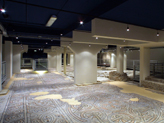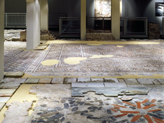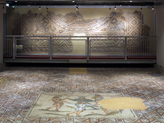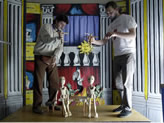Domus dei Tappeti di Pietra - Ravenna
Chiesa di S. Eufemia, via Barbiani 48121 Ravenna
Tel. 0544 32512 Fax 0544 32512
email info@ravennantica.it
web http://www.domusdeitappetidipietra.it
Apertura:
dal 1° marzo all'8 ottobre: tutti i giorni 10-18.30.
In occasione della Notte d'Oro (sabato 8 ottobre 2016) orario continuato dalle 10 alle 24.
dal 9 ottobre al 6 gennaio: dal lunedì al venerdì 10-17; sabato e domenica 10-18. Il 24 e il 31 dicembre aperta dalle 10 alle 14. Chiuso il 25 dicembre. Il 1 gennaio apertura dalle 10 alle 18.
Ingresso a pagamento: Intero € 4.00 - Ridotto € 3.00 - Scuole € 3.00
Visita guidata su prenotazione € 40,00 (durata 40 minuti)
Cumulativo Domus dei Tappeti di Pietra + Museo Tamo + Cripta Rasponi: Intero € 7.00 - Ridotto € 5.00
Accessibile ai diversamente abili
Tra i tanti edifici venuti alla luce, è di particolare interesse un palazzetto bizantino (inizio del VI secolo), di cui sono apparse quattordici stanze e tre cortili. Tutte le stanze dell'edificio - probabilmente di proprietà di un funzionario di corte - erano pavimentate in tarsia di marmo o a mosaico, raffinate geometrie e inserti figuranti in tessere policrome. I mosaici sono quasi tutti ben conservati: ricordiamo in particolare il mosaico della stanza n. 10, di notevole livello tecnico, che al centro raffigura la danza dei Geni delle Stagioni.
Dopo il loro restauro, a partire dal 2002 i Tappeti di pietra sono stati ricollocati nel luogo dove sono stati scoperti, in un ambiente sotterraneo appositamente realizzato al quale il pubblico può accedere dalla chiesa di Sant'Eufemia.
° ° ° ° ° °° ° ° °° °° ° °° °° ° °° °° °° ° °° °° °° °° °° °° °° °° °°° °°° °° °° °°° °°° °° °
The archaeological complex of the Domus dei Tappeti di Pietra- which literally translates as "House of the Floor Mosaics"- emerged following building works begun in1993 for the construction of a residential complex. The dig, which lasted for approximately 2 years, is considered one of the greatest archaeological operations even carried out in Ravenna, both in terms of the total surface area of the dig -measuring more than 850 metres square- and its character as the most complex and complete stratification of past constructions ever uncovered.
The structure visible inside the exhibition area date back to the Byzantine Age, when Ravenna was the capital of the Western Roman Empire; a tangible sign of the radical urban upgrading and reconstructing brought about by the presence of the Imperial Court and which involved the entire city.
In this area, the creation of a new urban layout took place during the last decades of the V Century, and lasted until the first few years of the following century, when this building was constructed, partly exploiting the pre-existing masonry structures and identifiable as a palace in the full sense of the term.
Inside the building were residential rooms (the living quarter of the master of the house, his family and guests of high standing) alongside spaces used for reception purposes, with saloons and large rooms where the public and administrative activities of the dominus -a Latin term meaning "lord"- were carried out.
The richness of the decorations and the materials used in their creation, together with the fact that a public road was incorporated inside the palace perimeter, suggest that this was not simply the home of a very rich citizen, but the residential palace of an important figure of the Imperial Court.
The floor plan of the palace is very elaborate. The rooms are sumptuously decorated with mosaics floors and marble intarsia and are arranged around various courtyards, some of which are paved in stone, while another certainly had an octagonal fountain.
These floors are characterised by a rich colour palette in the tones of red, pink, blue, white and black and most of all have geometrical decorative motifs, as a true and proper carpet.
Between the many brought to life, of particular interests are the mosaics of the "Good Shepherd" and of "The Genii of the dance of the Four Seasons".
The first was crafted during a period of building preceding that of Byzantine Palace and it probably belongs to the Latin era. The scene shows a young man standing up, depicted frontally. He is leaning on a long stick positioned under is left armpit and his leg are crossing in a resting position.
The identify of the figure has long been a subject of debate. Some believe it is a depiction of Christ the Good Shepherd, others consider it as Orpheus. In reality, the theory of this particular work as one with a somewhat transient character is a plausible one. Not Orpheus, nor Christ, but perhaps it is the idealised image of the master of the house, depicted here for auto celebratory reasons, as a wise administrator carrying prosperity and protection.
Instead the panel depicting the scene of the Dance of the Genii of the Four Seasons decorated the centre of the floor mosaic in the large dining room. The Genii dance in a circle holding hands, while a musician plays a panpipe in the background. The representation of the scene in perspective and the heightened realism, accentuated by the shadows, suggest that this scene derives directly from an easel work of Constantinopolitan production. There are also slight differences in the laying of the tesseras, indicating the work of different artists.
The particular delicacy of this mosaic picture and the difficulties involved in preserving it, suggests it was removed from the floor where it was originally set and exhibited on the wall, where it is easier to observe the infinity of minute details and fully appreciate the refinement of this mosaic artwork.




